Plains
Sunflower
Helianthus petiolaris
Aster family (Asteraceae)>
Helianthus petiolaris
Aster family (Asteraceae)>
Description:
This plant is a summer annual about 1–3' (0.3–0.9 m.) tall, branching
occasionally. The stems are light green, terete, and somewhat stout;
they have short white hairs that are ascending. Alternate leaves occur
at intervals along the stems, becoming gradually smaller in size as
they ascend. Individual leaves are 1–6" (2.5–15 cm.) long and 1/3–2½"
(8–60
mm.) across; they are deltate-ovate to narrowly lanceolate in shape.
The margins of the leaves are toothless or shallowly and sparsely
dentate; they may undulate up and down as well. The upper leaf surface
is light-medium green and sparsely covered with short appressed hairs;
the lower leaf surface is light or whitish green and moderately covered
with short appressed hairs. Except for the smallest narrow leaves, each
leaf has a prominent central vein and two prominent lateral veins. The
narrow petioles of the leaves are ½–4" (1.2–10 cm.) in length; they are
light green or light purple with short white hairs.
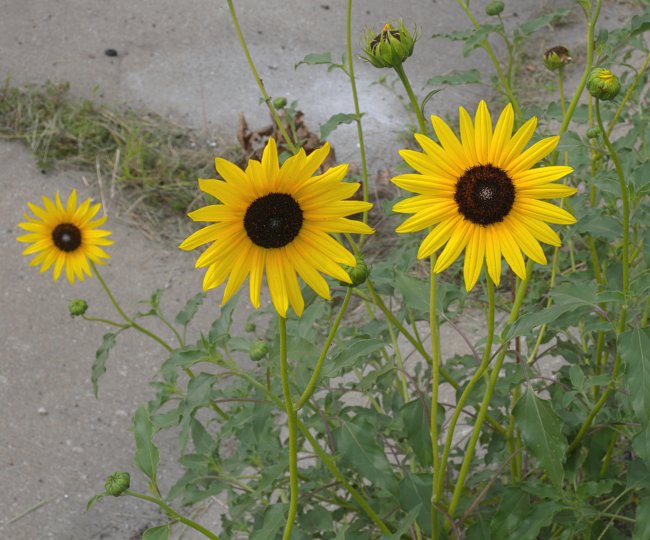
The upper stems terminate in 1–5 flowerheads spanning 1½–3" (3.5–7.5 cm.) across. Each flowerhead has 10–30 ray florets and 50–100 disk florets. The petaloid rays are bright yellow and oblong in shape; each ray has a pair of longitudinal channels. The ray florets are sterile. The corollas of the disk florets are about 6 mm. long, narrowly tubular in shape with 5 lobes, and either reddish brown or dark purple (at least above). The styles and tubular anthers are the same color as well; the disk florets are fertile and perfect. Inserted among the disk florets, there are 3-lobed chaffy scales (middle lobe is longest) about 6 mm. long. The tips of the middle lobes are white-hairy and they are usually visible toward the center of each flowerhead during the blooming period. At the base of the flowerhead, there are light-medium green floral bracts in 3 overlapping series. These bracts are narrowly lanceolate with long tapering tips; they are moderately covered with very short white hairs on the outer surface, while their margins are short-ciliate with the same kind of hairs.
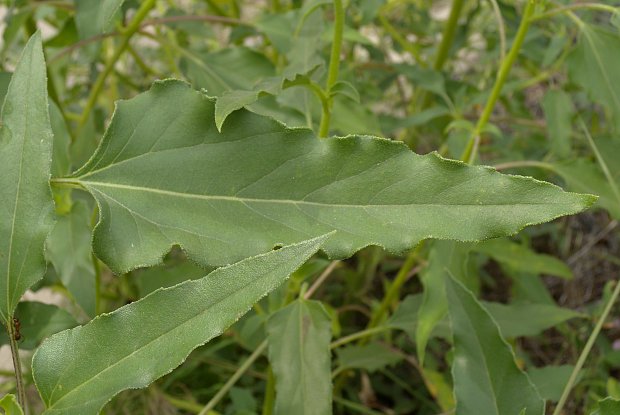
The erect to ascending peduncles of the flowerheads are 2–16" (5–40 cm.) long; the flowerheads nod laterally from their peduncles. These peduncles are sparingly branched or unbranched, largely devoid of leafy bracts, and similar to the stems in their characteristics. The blooming period occurs from mid-summer to mid-autumn, lasting about 2 months for a colony of plants. Fertile disk florets are replaced by achenes about 3–4.5 mm. long (one achene per disk floret). Individual achenes are mottled brown, finely hairy (at least while young), ellipsoid-oblanceoloid in shape, somewhat flattened, and slightly four-angled. At the apex of each achene, there is a pair of deciduous narrowly triangular scales about 1.5–3 mm. long. The root system consists of a taproot. This plant reproduces by reseeding itself. It occasionally forms colonies of plants at favorable locations.
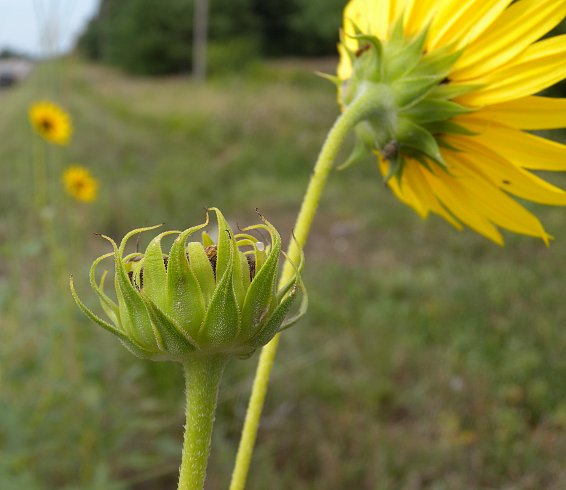
Cultivation: The preference is full sun, mesic to dry conditions, and sandy soil. The seeds should be planted during the spring after the danger of frost has passed.
Range & Habitat: Plains Sunflower (Helianthus petiolaris) has been found in many counties of Illinois, especially in the western half and northern half of the state (see Distribution Map). In sandy areas, it is occasional within the state, while in non-sandy areas it is rare. This plant is adventive from the west. It is widely distributed in the United States, except for the Southeast, and probably native to the Great Plains and adjacent regions. Habitats include sand prairies, roadsides, areas along railroads, sandy fields, and waste areas. Habitats with a history of disturbance are strongly preferred.
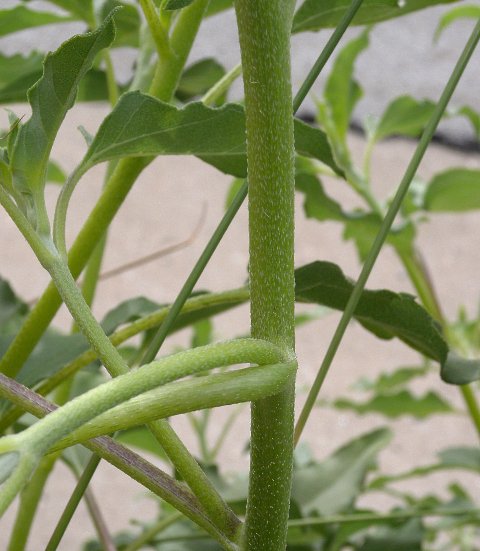
Faunal Associations: The nectar and pollen of the flowerheads of Plains Sunflower (Helianthus petiolaris) attract bees, wasps, beetles, and other insects. Among the bees, are such floral visitors as Dufourea marginata, Perdita spp., and Bombus spp. (Stevens, 1919; Stevens, 1950; LaBerge & Webb, 1962). Many insects feed destructively on the foliage, stems, flowerheads, and roots of this sunflower. These insect feeders include the larvae and/or adults of Zygogramma exclamationis (Sunflower Beetle), Baris strenua (Sunflower Root Weevil), Cylindrocopturus adspersus (Sunflower Stem Weevil), Smicronyx fulvus (Red Sunflower Seed Weevil), Smicronyx sordidus (Gray Sunflower Seed Weevil), Contarinia schulzi (Sunflower Midge), Neotephritis finalis (Sunflower Seed Maggot), Homoeosoma electellum (Sunflower Moth), Cochylis hospes (Banded Sunflower Moth), and Suleima helianthana (Sunflower Bud Moth); see Charlot & Gavloski (2011).
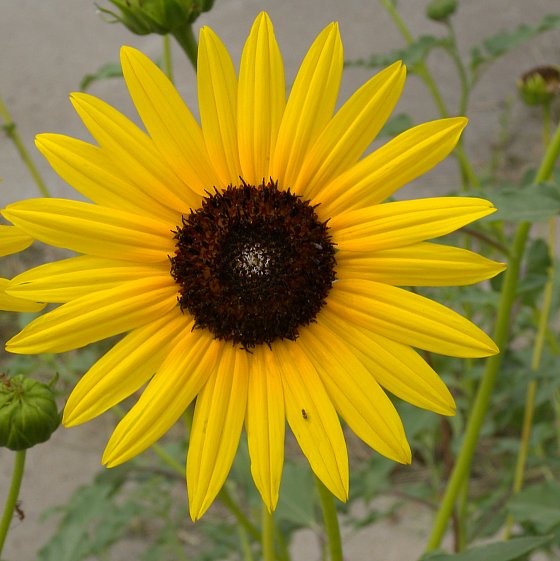
There are also many grasshoppers that feed on this sunflower, including Hesperotettix speciosus (Western Grass-green Grasshopper) and several Melanoplus spp. (Spur-throated Grasshoppers); see Joern (1985), Brust et al. (2008, and Wyoming Agr. Exp. Station (1994). The seeds of sunflowers (Helianthus spp.) are an important source of food to upland gamebirds and granivorous songbirds, including the Bobwhite Quail, Hungarian Partridge, Ring-necked Pheasant, American Crow, Mourning Dove, Lark Sparrow, Lincoln Sparrow, Savanna Sparrow, White-crowned Sparrow, American Goldfinch, Common Grackle, Red-winged Blackbird, and Western Meadowlark (Martin et al., 1951/1961; Trigg, 1951). Mammals that feed on the seeds and other parts of sunflowers include the Prairie Vole, Thirteen-lined Ground Squirrel, and Plains Pocket Gopher.
Photographic Location: A roadside in Mason County, Illinois.
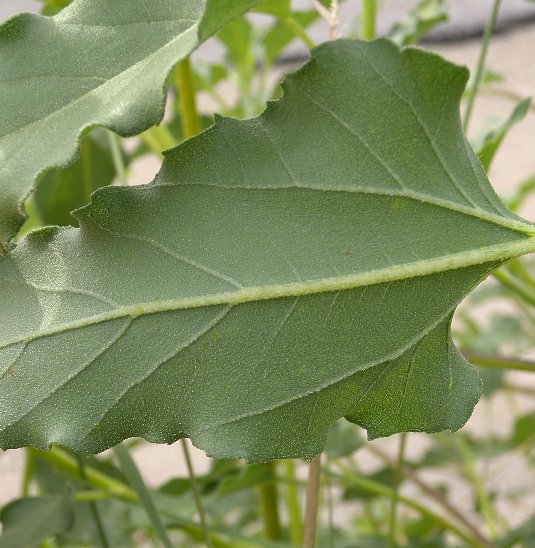
Comments: The Plains Sunflower (Helianthus petiolaris) can be cultivated in sunny gardens, especially where the soil is sandy. The flowerheads are very showy. It is somewhat similar to the better known Annual Sunflower (Helianthus annuus), which is also an annual plant. The Plains Sunflower differs from this latter species by having more narrow leaves, more narrow floral bracts (phyllaries), and smaller flowerheads. In particular, the center of its flowerheads, where the disk florets occur, is usually whitish in appearance because of the hairs on its floral chaff. The seeds of Plains Sunflower are also smaller in size than those of the Annual Sunflower, and mottled. When these two species grow together, hybrid plants with mixed characteristics can occur. Other common names of Helianthus petiolaris are Prairie Sunflower, Lesser Sunflower, Petioled Sunflower, and Kansas Sunflower.

The upper stems terminate in 1–5 flowerheads spanning 1½–3" (3.5–7.5 cm.) across. Each flowerhead has 10–30 ray florets and 50–100 disk florets. The petaloid rays are bright yellow and oblong in shape; each ray has a pair of longitudinal channels. The ray florets are sterile. The corollas of the disk florets are about 6 mm. long, narrowly tubular in shape with 5 lobes, and either reddish brown or dark purple (at least above). The styles and tubular anthers are the same color as well; the disk florets are fertile and perfect. Inserted among the disk florets, there are 3-lobed chaffy scales (middle lobe is longest) about 6 mm. long. The tips of the middle lobes are white-hairy and they are usually visible toward the center of each flowerhead during the blooming period. At the base of the flowerhead, there are light-medium green floral bracts in 3 overlapping series. These bracts are narrowly lanceolate with long tapering tips; they are moderately covered with very short white hairs on the outer surface, while their margins are short-ciliate with the same kind of hairs.

The erect to ascending peduncles of the flowerheads are 2–16" (5–40 cm.) long; the flowerheads nod laterally from their peduncles. These peduncles are sparingly branched or unbranched, largely devoid of leafy bracts, and similar to the stems in their characteristics. The blooming period occurs from mid-summer to mid-autumn, lasting about 2 months for a colony of plants. Fertile disk florets are replaced by achenes about 3–4.5 mm. long (one achene per disk floret). Individual achenes are mottled brown, finely hairy (at least while young), ellipsoid-oblanceoloid in shape, somewhat flattened, and slightly four-angled. At the apex of each achene, there is a pair of deciduous narrowly triangular scales about 1.5–3 mm. long. The root system consists of a taproot. This plant reproduces by reseeding itself. It occasionally forms colonies of plants at favorable locations.

Cultivation: The preference is full sun, mesic to dry conditions, and sandy soil. The seeds should be planted during the spring after the danger of frost has passed.
Range & Habitat: Plains Sunflower (Helianthus petiolaris) has been found in many counties of Illinois, especially in the western half and northern half of the state (see Distribution Map). In sandy areas, it is occasional within the state, while in non-sandy areas it is rare. This plant is adventive from the west. It is widely distributed in the United States, except for the Southeast, and probably native to the Great Plains and adjacent regions. Habitats include sand prairies, roadsides, areas along railroads, sandy fields, and waste areas. Habitats with a history of disturbance are strongly preferred.

Faunal Associations: The nectar and pollen of the flowerheads of Plains Sunflower (Helianthus petiolaris) attract bees, wasps, beetles, and other insects. Among the bees, are such floral visitors as Dufourea marginata, Perdita spp., and Bombus spp. (Stevens, 1919; Stevens, 1950; LaBerge & Webb, 1962). Many insects feed destructively on the foliage, stems, flowerheads, and roots of this sunflower. These insect feeders include the larvae and/or adults of Zygogramma exclamationis (Sunflower Beetle), Baris strenua (Sunflower Root Weevil), Cylindrocopturus adspersus (Sunflower Stem Weevil), Smicronyx fulvus (Red Sunflower Seed Weevil), Smicronyx sordidus (Gray Sunflower Seed Weevil), Contarinia schulzi (Sunflower Midge), Neotephritis finalis (Sunflower Seed Maggot), Homoeosoma electellum (Sunflower Moth), Cochylis hospes (Banded Sunflower Moth), and Suleima helianthana (Sunflower Bud Moth); see Charlot & Gavloski (2011).

There are also many grasshoppers that feed on this sunflower, including Hesperotettix speciosus (Western Grass-green Grasshopper) and several Melanoplus spp. (Spur-throated Grasshoppers); see Joern (1985), Brust et al. (2008, and Wyoming Agr. Exp. Station (1994). The seeds of sunflowers (Helianthus spp.) are an important source of food to upland gamebirds and granivorous songbirds, including the Bobwhite Quail, Hungarian Partridge, Ring-necked Pheasant, American Crow, Mourning Dove, Lark Sparrow, Lincoln Sparrow, Savanna Sparrow, White-crowned Sparrow, American Goldfinch, Common Grackle, Red-winged Blackbird, and Western Meadowlark (Martin et al., 1951/1961; Trigg, 1951). Mammals that feed on the seeds and other parts of sunflowers include the Prairie Vole, Thirteen-lined Ground Squirrel, and Plains Pocket Gopher.
Photographic Location: A roadside in Mason County, Illinois.

Comments: The Plains Sunflower (Helianthus petiolaris) can be cultivated in sunny gardens, especially where the soil is sandy. The flowerheads are very showy. It is somewhat similar to the better known Annual Sunflower (Helianthus annuus), which is also an annual plant. The Plains Sunflower differs from this latter species by having more narrow leaves, more narrow floral bracts (phyllaries), and smaller flowerheads. In particular, the center of its flowerheads, where the disk florets occur, is usually whitish in appearance because of the hairs on its floral chaff. The seeds of Plains Sunflower are also smaller in size than those of the Annual Sunflower, and mottled. When these two species grow together, hybrid plants with mixed characteristics can occur. Other common names of Helianthus petiolaris are Prairie Sunflower, Lesser Sunflower, Petioled Sunflower, and Kansas Sunflower.